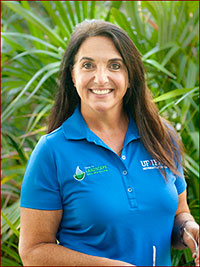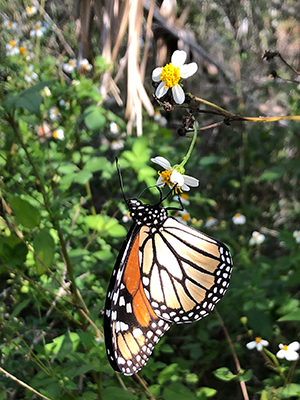Wendy's Wanderings
November 7, 2019
A Welcome Weed
Spanish needles (Bidens alba) has been a part of my life for as long as I can remember. I can surely remember pulling the seeds from my bobby socks after walking through the grove on my way to the school bus stop or pulling this perennial weed from my first vegetable garden. Suffice to say the ill feelings go way back.
This weed is a perennial herb that can grow up to 4 feet tall. It has finely toothed leaves that can be simple or compound. The 1-inch wide flowers look like little daisies with white ray flowers and yellow disk flowers in the center. And then there are the seeds, achenes actually, that are 1 cm long and needle-like, with two little gripper "teeth" that will cling to clothing, fur, pant legs, and even shoes. Bidens is Latin for "two toothed" in reference to the teeth on the dry seed that grip to everything.
These weedy native plants are found in pinelands, roadsides, and disturbed sites in every county of Florida. I have long fussed to gardeners about how much this plant irks me. These kind green thumbs remind me that Bidens alba provides for honey bees, butterflies, and other pollinators. One Master Gardener Volunteer even proved its virtues as an edible plant by making a type of spinach-ball recipe with the leaves and serving this dish at a potluck lunch. I still wasn't swayed into accepting this plant in to my heart.

Monarch on Spanish needle, Wendy Wilber.
But gentle reader, my heart has thawed in regards to Bidens alba following a visit to the Florida panhandle to witness the monarch butterfly migration. Late in October to early November thousands of monarch butterflies gather on the coast of Florida's panhandle before continuing their migration crossing in to Mexico. In the sunshine of St. Mark's wildlife refuge I saw the monarchs tanking up on nectar from salt bush (Baccharis sp.), goldenrod (Solidago sp.) and—you guessed it—Spanish needles (Bidens alba).
It was blatantly obvious how important this nectar source was for these butterflies. This white-flowering Florida native is a favorite plant for pollinators. And it is a tough plant, with seeds that will travel and germinate almost anywhere in Florida including sidewalk cracks, and bloom even when mowed by the highway crew. If you have held Spanish needles in disdain, please make a little space in your heart and in your landscape (the wild part) for this important pollinator plant. I have.
-- Wendy Wilber

